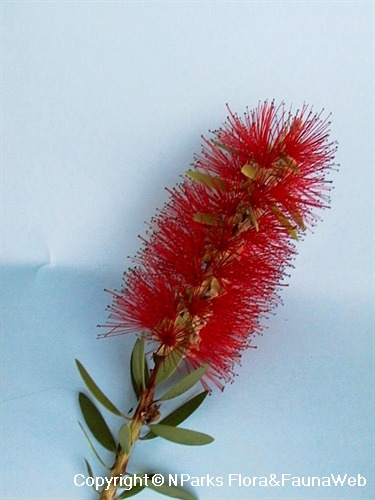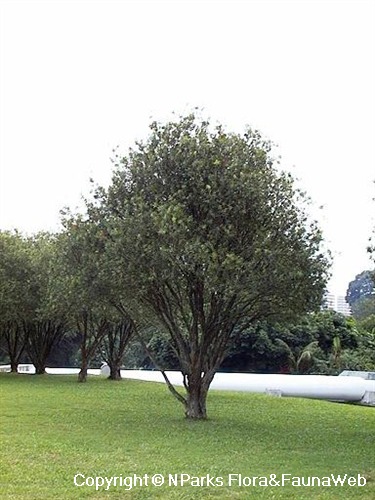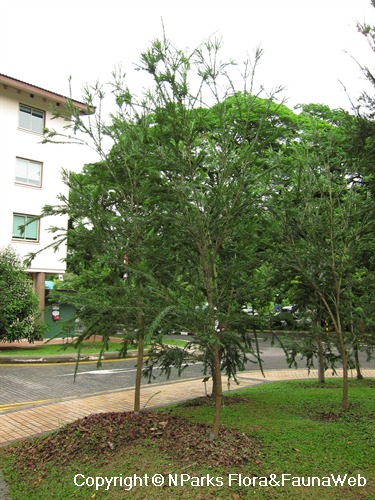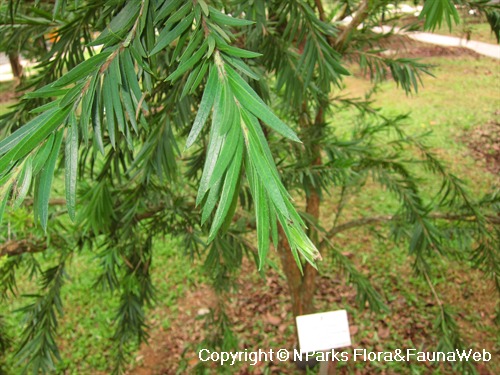
Back
Melaleuca citrina (Curtis) Dum.Cours.
| Family Name: | Myrtaceae |
| Synonyms: | Callistemon citrinus (Curtis) Skeels |
| Common Name: | Bottlebrush Tree, Crimson Bottlebrush, Lemon Bottlebrush, Lemon Scented Bottlebrush |
Name
Classifications and Characteristics
| Plant Division | Angiosperms (Flowering Seed Plants) (Dicotyledon) |
|---|---|
| Plant Growth Form | Tree |
| Lifespan (in Singapore) | Perennial |
| Mode of Nutrition | Autotrophic |
| Maximum Height | 8 m |
| Maximum Plant Spread / Crown Width | 6 m |
Biogeography
| Native Distribution | Australia |
|---|---|
| Native Habitat | Terrestrial |
| Preferred Climate Zone | Sub-Tropical / Monsoonal |
| Local Conservation Status | Non-native (Horticultural / Cultivated Only) |
Description and Ethnobotany
| Growth Form | A large shrub to small tree, up to about 7-8m tall, with a life span of slightly over a decade in its place of origin. |
|---|---|
| Trunk | It has brownish grey bark that becomes increasingly fissured with age, and has upright branches. |
| Foliage | Leaves are alternate, simple, lanceolate to elliptical, about 7 x 2cm long, and texture is smooth and leathery. Young leaves have a silky texture, and may be pinkish or red. Despite the specific epithet citrinus, and the common name Lemon Scented Bottlebrush, the leaves are not very strongly scented and only emits a faint citrus fragrance when crushed. |
| Flowers | Distinctive red inflorescences, in the form of “brushes” (hence the common names), in which the “bristles” are actually stamens (see etymology). The apical buds continue to grow leafy sections, resulting in the branches to appear to alternate between leafy and floral sections. |
| Fruit | Small sessile woody capsules clustered around the stems. Each capsule contains numerous tiny seeds. |
| Similar | To differentiate from its close relative Callistemon viminalis, one two major distinctions are is (1) the branches of M. citrina are upright and C. viminalis are drooping that and (2) M. citrina retains the seeds (in the fruit) on the tree for a long time, sometimes even for years, whereas C. viminalis sheds its seeds annually. |
| Cultivation | Prefers well-drained, sandy loam soils with regular watering but can survive in poor soils with infrequent watering. Requires partial to full sun. Propagates from seeds and cuttings. Caution: Easily hybridizes with Callistemon species, resulting in highly variable offspring from seeds, therefore quality seed source is essential for volume planting of the typical form, otherwise propagation by cutting is preferred for retaining cultivars. |
| Ethnobotanical Uses | Others: Flowers are used in floral arrangements. Wood can be used as firewood and for making tool handles. |
Landscaping Features
| Desirable Plant Features | Ornamental Flowers, Fragrant (Foliage) |
|---|---|
| Landscape Uses | Suitable for Roadsides, General |
Fauna, Pollination and Dispersal
| Fauna Pollination Dispersal Associated Fauna | Bird-Attracting |
|---|
Plant Care and Propagation
| Light Preference | Full Sun |
|---|---|
| Water Preference | Moderate Water |
| Plant Growth Rate | Moderate |
Foliar
| Mature Foliage Colour(s) | Green |
|---|---|
| Leaf Area Index (LAI) for Green Plot Ratio | 2.5 (Tree - Open Canopy) |
Floral (Angiosperm)
| Flower Colour(s) | Red |
|---|
Image Repository
Others
| Master ID | 1479 |
|---|---|
| Species ID | 2772 |
| Flora Disclaimer | The information in this website has been compiled from reliable sources, such as reference works on medicinal plants. It is not a substitute for medical advice or treatment and NParks does not purport to provide any medical advice. Readers should always consult his/her physician before using or consuming a plant for medicinal purposes. |







